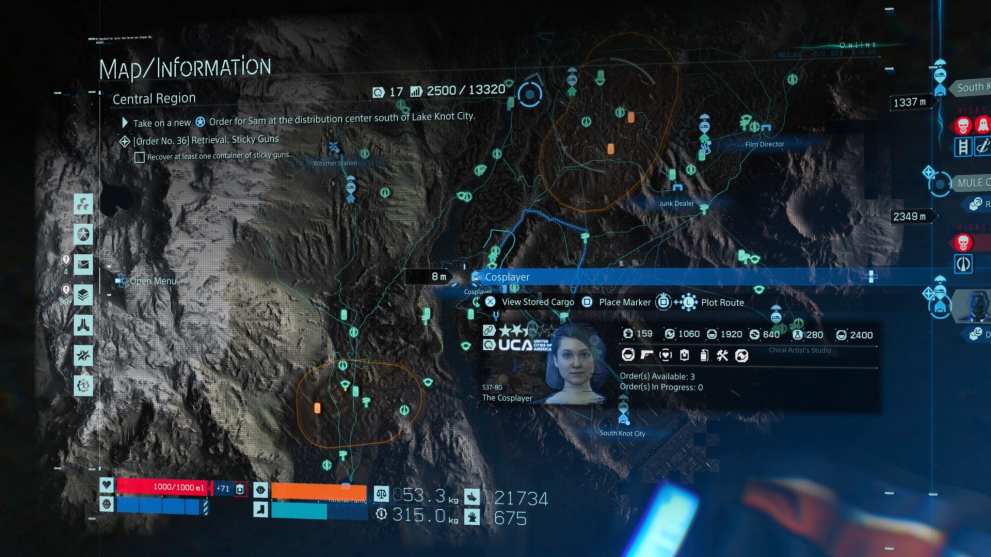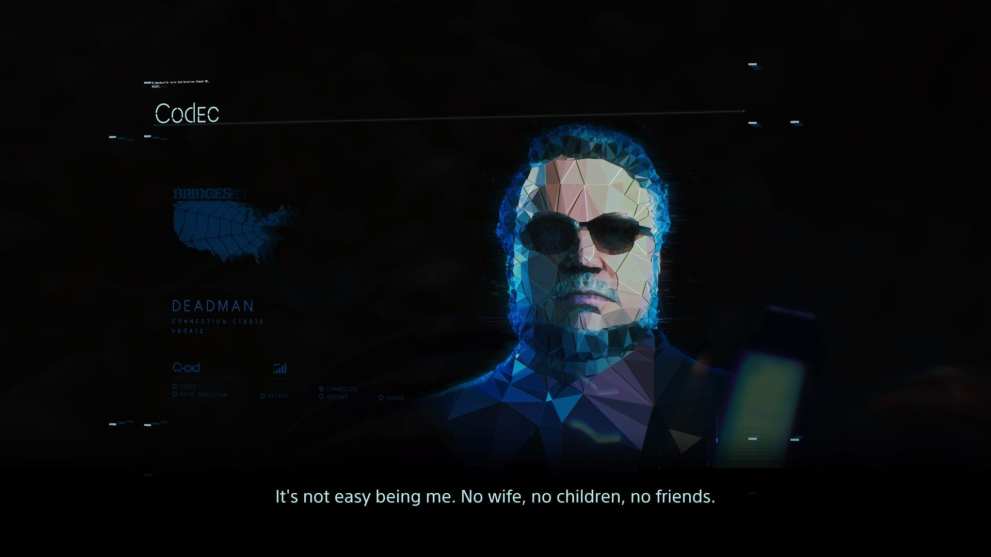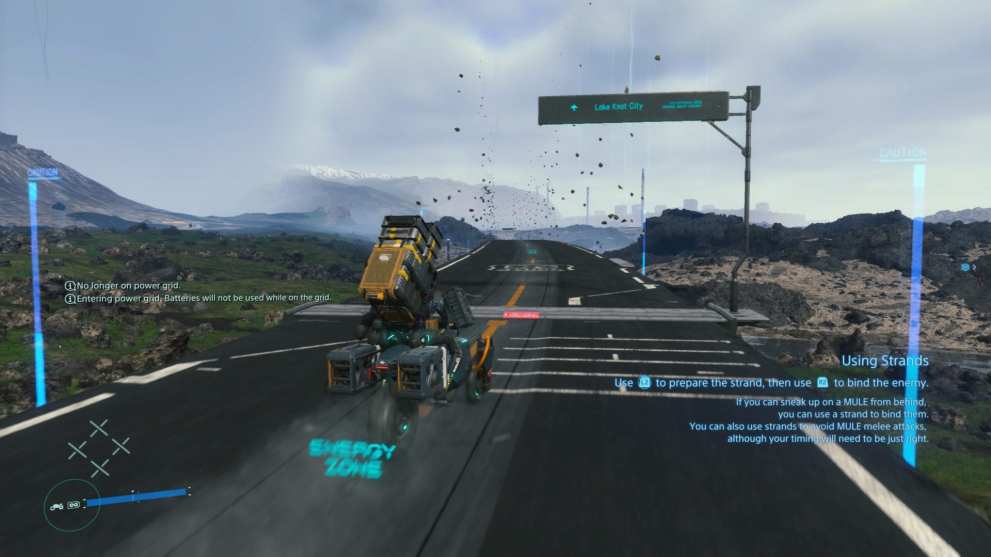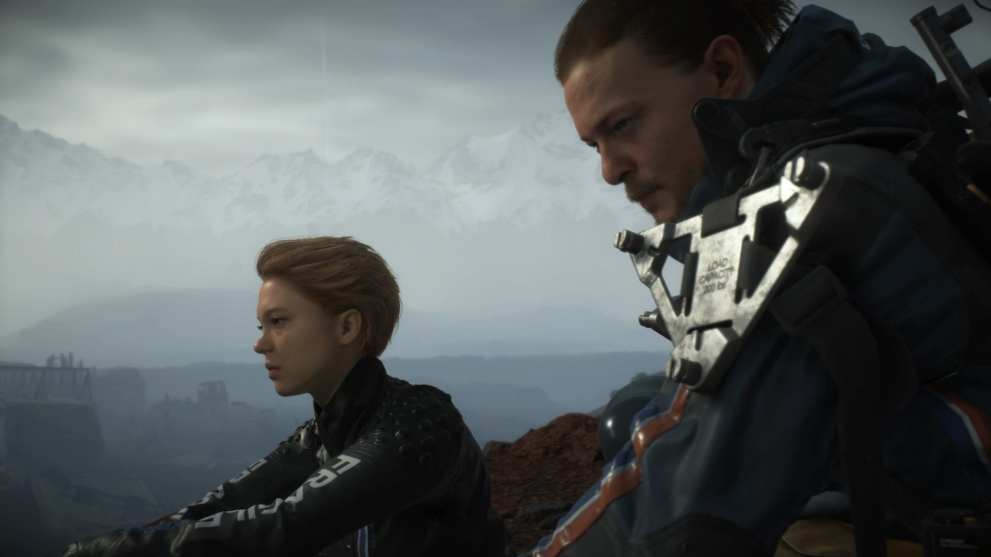Death Stranding on PS4
Think about the concept of a modern video game in its purest form. Most video games are built around the idea of filling up bars –progress bars, experience bars, the list goes on– and completing activities to fill up said bars. Aforementioned activities usually involve killing things or fetching things, and Death Stranding leans hard into the latter.
The entire game is built around fetch quests, and it’s still compelling. Death Stranding is very much the quintessential video game-y video game, warts and all.
Set in a post-apocalyptic version of America, the world has been torn apart by a cataclysmic event known as the Death Stranding. People who die linger on in the world as BTs — supernatural beings that haunt the living. Corpses left behind trigger a voidout, which is basically a large explosion that leaves a giant crater in the land.
The lines between life and death are heavily blurred in Death Stranding’s world, and the people left behind in the realm of the living can’t seem to let go of the past either. With how fractured the world has become, you take on the role of a deliveryman, tasked with making deliveries all over the continent and reconnecting cities, bringing them into the fold in the form of a chiral network that links everyone together.
Norman Reedus of The Walking Dead fame plays Sam Porter Bridges, an anti-hero type who’s lost faith in the world and the idea of America. However, bolstered by a sense of familial love and responsibility for his adopted sister Amelie, he’s resolved to travel across America to rebuild the chiral network and save her from a bunch of terrorists who have kidnapped her.
And that’s basically all you need to know about the gameplay. Combat and action are very much not the focus of Death Stranding; you’re a deliveryman, you just make deliveries, that’s all.
Death Stranding’s gameplay loop revolves around you taking on different orders at a delivery terminal in a city, then traveling to your destination to turn in those packages. The difficulty of this game comes with the terrain navigation. With America being bombed to hell from the Death Stranding, it’s become a treacherous, mountainous region filled with uneven and unpredictable terrain.
Even the rain itself is dangerous; referred to as timefall, this is essentially acidic rain that ages whatever it touches at an accelerated rate. Get caught out in the timefall for too long, and your packages will start to deteriorate, lowering your delivery score.

Armed with only a map and a few basic tools at the start, you’ll have to plot your route carefully from point A to point B, and find a way to make your delivery in an efficient manner. You’re supplied with ladders and climbing anchors in the beginning to make your climb easier, but you’ll always have to manage a careful balancing act between carrying too many tools, and making space for more cargo packages so you don’t have to make too many return trips.
The moment-to-moment gameplay is a literal balancing act as well. The L2 and R2 buttons are reserved for gripping your backpack straps to maintain balance as you’re hiking. Walking around in this game, especially when you’re loaded with cargo, is a constant micromanagement of small details. Tripping over the tiniest rock could send you spiraling towards the ground, and wading too deep into the river could cause you to drop all your cargo, letting it wash away into the ocean with no hopes of recovery.
Then, you’ll need to keep an eye on the durability of Sam’s boots, as letting them wear out will cause your feet to bleed, impeding movement and draining health. You’ll need to keep your cargo containers in tip-top shape, because delivering damaged goods is frustrating and we all know how it feels to receive a package only to see that everything inside’s completely wrecked.
Then, there are the MULEs and BTs to deal with. BTs are the otherworldly ghosts who haunt the world, and they’re best dealt with by sneaking past them. Armed with a Bridge Baby (BB for short), Sam has the ability to sense BTs when they’re nearby, and you can sneak past them easily by holding your breath till you make it out of the infested area.
The BTs are what make Death Stranding feel legitimately horrifying. Not in a “boo, I scared you” kind of way, but more of a “wow, these BTs were actual human beings who can’t seem to cut their ties with the living and so they have no choice but to roam the world and desperately cling on to the first sign of life they see and that’s really sad” kind of way.
Death Stranding has a lot going on for it thematically, but more on that later.

The MULEs, on the other hand, are human enemies who — I kid you not– get high off stealing packages and making deliveries. It sounds absolutely ridiculous but that’s exactly how the game sets them up. And you know what? The more I played Death Stranding, the more I began to understand exactly how the MULEs felt.
Making deliveries is satisfying, I do get a mini high off completing an order and receiving hundreds of Likes for my efforts. I like picking up the lost cargo of other players and completing deliveries for them and feeling like an absolute god when those progress bars fill up, cementing my status as a total alpha delivery person. I’d gotten completely addicted to Death Stranding’s fetch quest style gameplay loop.
Before long, I had to ask myself that terrifying, existential question: am I… a MULE? What does the fact that I enjoy doing fetch quests to fill up arbitrary progress bars in a video game say about me as a person?
Jokes aside, though, that’s how good the gameplay loop is in Death Stranding. It’s essentially Menu-ing: The Game, mixed with a perfected version of the walking simulator and a dash of occasional stealth combat.
While the game’s UI could use some work in giving players better clarity in what they’re actually doing and equipping, there’s an inherent sense of satisfaction that comes with loading Sam up with a crap ton of cargo and completing multiple delivery orders in one go. You’ll accept your orders, look at your map and plot out a nice route to hit up multiple destinations, and revel in the delight of being the world’s most efficient postman.
The challenges that come with terrain navigation make the journey even sweeter. The awesome thing about Death Stranding is that because combat isn’t the focus here, the difficulty increases in interesting ways that are entirely non-combat related. The terrain gets harder and trickier to navigate as you go further west, along with new weather conditions and environmental hazards to consider.
To make things a little easier on you, the asynchronous multiplayer aspect of Death Stranding allows you to see items and structures left behind by other players. It could be something as simple as a ladder left in a convenient spot to let you cross a stream, or something even bigger and grander like the joint multiplayer effort to build a highway on the foundations left behind by another player.
This is the core of what makes Death Stranding feel so special. There’s incentive to help build and maintain structures by other players because by doing so, you’re making life easier for yourself, and you’re also helping out your fellow porters. The resources required to build a highway, for instance, are astronomical and near impossible for any one player to achieve on their own without spending a lot of time grinding.
You need the help of the other players to build this incredible thing, and there’s nothing quite like that ecstatic sense of pride and accomplishment when you’re cruising down a highway on your bike with the knowledge that, hey, you helped build this thing, enjoy it.

And, of course, the trickier your deliveries, the more those progress bars fill up. Your Porter Grade increases as you make more deliveries, allowing you to carry more cargo at once, form more Strand Contracts with other players so you can see their structures more often, and receive more Likes.
In so many shallow ways, Death Stranding is a video game that truly appeals to the current generation. You’ve got that feeling of satisfaction that comes with carrying all your groceries back home (or to multiple destinations) in one go, you’re doing all these things and building structures for Likes and validation from both NPCs and other players, you’re increasing connection levels for more internet bandwidth, and most importantly, you’re filling up those progress bars –whether it’s for your Porter Grade or just material donation for another player’s structure.
Death Stranding was described as an open world social strand game, and I finally get it. The gameplay informs the story as well, and when you have both gameplay and narrative working together in tandem, you get a video game that feels good to play.
Much like in the Metal Gear series, the characters in Death Stranding aren’t really meant to be depicted as actual, relatable people. Kojima’s characters are often representative of ideas and metaphors to drive home a larger point, and Death Stranding really wants you to know that.
It’s obvious in the way the characters are named: Deadman for the man who’s obsessed with death, Heartman for the man who gives himself a cardiac arrest every 21 minutes so he can visit the afterlife, and Die-Hardman for the man who… doesn’t die?
The most obvious examples are, of course, Sam Porter Bridges himself and Bridges, and Bridget Strand. At one point, you get a scene of a character singing London Bridge. I was like, oh, having a character named Bridges isn’t enough; we have to start singing about literal bridges too.
Put aside all of the sci-fi, supernatural mumbo jumbo of Death Stranding for a while, and you’ll see that this game’s core message is about bringing people together and understanding that humanity needs to stand together to survive. Whether it’s on a national or personal level, “living is the same as being dead if you’re alone.”

Death Stranding is a game that wants to impart a message of positivity. It lightly deals with themes of parenthood, the idea of letting go of the past and embracing the future, and always working towards a better tomorrow. No matter how close humanity comes to the edge of doom and extinction, every passing moment is another chance to turn it all around. Quite literally, Death Stranding is about the friends we made along the way, and what a group of friends they are.
As you might expect from a Hideo Kojima game, the writing in Death Stranding isn’t particularly great, nor is the overall story actually all that interesting. The dialogue is on the nose, and the writing is about as subtle as a sledgehammer. But the acting and performances are truly on another level, and that’s what keeps you invested in Death Stranding and the messages it wants to convey.
The entire cast is excellent, which I suppose is to be expected when you’re pulling names out of the Hollywood film scene and putting them in a video game. Mads Mikkelsen and Lea Seydoux, in particular, are so committed to their performances that it leads to some incredible story moments that truly moved me. Even when the writing is so laughably bad (“I brought you a metaphor.”), you can’t help but feel for these characters. The actors really go for it in Death Stranding, and their passion for the characters they portray is truly something to behold.
Death Stranding isn’t a masterpiece; it doesn’t have the nuance or depth for that kind of lofty praise, but it does straddle the line between being just a video game and a tool that pulls people together. Death Stranding revels in the mundane and the simple joy of taking a hike while delivering packages from one place to another. It also has something to say about human nature and the resilience of our species, and while the message itself gets muddied in all the other overwrought filler that bogs down the game, it feels earnest, heartfelt, and genuine.
Death Stranding calls us all out for being mere MULEs, but also reminds us that we can be so much more than that.
Score: 4.5/5 – Great
Pros
- This game finally made ‘fetch’ happen. But seriously, fetch quests are done well and make you feel like you’re working towards something grander.
- The game’s difficulty increases in interesting ways, constantly changing up how you approach terrain navigation and environmental hazards.
- The actors and voice actors are just sublime in their performances, making a script seem good even during its lowest points.
- The asynchronous multiplayer aspect is a fantastic feature that informs the overarching theme of the story.
Cons
- Stealth and combat are just way too easy that they feel a little tacked-on for the sake of it.
- The writing can be quite bad.
If you’re looking to play the purest modern video game about fetch quests and filling up bars, yes. If you’re looking for a unique gameplay experience and great acting, also yes.
The game was officially released for PS4 on Nov. 8, and will be coming to PC in 2020.
The game was developed by Kojima Productions, and created by Hideo Kojima.
For more information on how we review games, check out Twinfinite’s review policy here.
